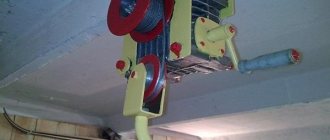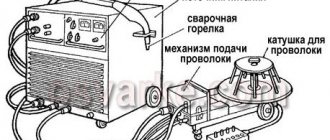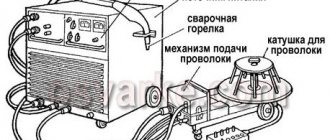Working in a garage in the cold season is below average pleasure. Without heating, even in a building with stone walls it is cold in winter, and in a metal box this is sometimes completely impossible. A garage stove made from a gas cylinder, which can quickly raise the temperature in the room, will help solve the problem. You can make such a design yourself or order it from a good craftsman. Making a stove will require skills in handling a welding machine, an angle grinder and minimal engineering knowledge. There is no need to buy materials - there is always a lot of unnecessary metal in the garage.
Pros and cons of a gas cylinder garage stove
The main task of the stove is to warm up the garage. She copes with this in a short time and with low fuel consumption. As a rule, food is not cooked on a stove from gas cylinders; at most, they heat up dishes taken from home or boil a kettle. If such functions are not needed, then you can limit yourself to the simplest option of one cylinder without a hob.
Types of garage stoves:
- Simple design. A small stove for a garage is built with your own hands from one cylinder with a capacity of 12-27 liters. It is installed horizontally or vertically.
- A stove made of two containers. There are different connection options available here. Two cylinders are placed with the long side above each other and connected by welding. The design of cylinders welded at right angles is a little more complicated.
- Complex options from two or more containers. There may be cooking surfaces, heat exchange fins or baffles, an air damper and other improvements.
During operation, the stove body becomes red hot, the screens protect against burns and at the same time increase the efficiency of the heater by directing cold air from the floor to the cylinder.
Pros and cons of some design options:
- On a vertically installed stove, you can make a platform on top for heating food, but the wood will have to be chopped into small fragments so that it fits in the firebox.
- The horizontal option is simpler in this regard: firewood is loaded along the long side, so you can use any logs. However, it is quite difficult to arrange a burner on a horizontally located cylinder.
It is not too difficult to make a stove for a garage from 2 gas cylinders installed parallel to each other, but you will have to forget about the hob. Its advantages are that you can use long logs, which provides quick and relatively long heating of the garage. On a design with a perpendicular connection of containers, it is easier to make a burner for heating food, but the stove itself is more difficult to make.
Important! Gas cylinder stoves are only suitable for temporary heating of a garage. With constant work, there is a real threat of fire: the metal of the walls will burn out very quickly, and the fire will spread to flammable objects and substances, of which there is always a lot in the garage.
Main types of oven
A vertical stove is made more often, as it takes up little space and has a neat appearance.
The horizontal design is valued due to the large cooking surface area. The dimensions of the ash pan and the hole for storing firewood in any device are 10x20 and 20x30 cm, respectively. Their markings are applied both to the drawings and to the cylinder itself - this makes it easier to cut out. The location of the holes is chosen arbitrarily, depending on the type of stove.
With the help of such a stove you can heat the room and even cook food outside
The chimney is made from a steel pipe, cutting it into different sections and welding them together. Additionally, you need to insulate it with mineral wool and foil. You can use the finished potbelly stove indoors or outdoors. If the stove is used for cooking outdoors, then it is enough to attach a low pipe for the smoke to escape.
Vertical stove
To create a vertical stove from a propane cylinder, it is placed vertically. It is necessary to cut off the neck, use a marker to draw the markings of the ash pan, chimney and firebox. The holes are cut with a grinder or cutter. Reinforcing bars are cut into identical pieces, forming grate bars. They are welded to the body in parallel rows or in a snake. Hinges for doors are attached, doors are cut out of steel sheet or cast iron. A sliding mechanism or latches are welded to them.
See also: modern types of potbelly stoves.
A hob is necessary if food will be cooked or water will be heated on the stove. To create it, you need to cut out a metal part of suitable size and weld it to the top of the cylinder. After this, all joints and seams are checked for tightness and strength, cleaned and sanded.
The vertical oven is more popular because it takes up less space
The hole for the chimney should be located at the top of the cylinder or on the side, sometimes the pipe passes through the central opening. In the side part, the elbow is first attached, then the chimney itself. Smoke and combustion products come out through the pipe. A metal stand or strong legs are attached to the bottom of the cylinder. Additionally, you can prepare the foundation for the potbelly stove.
Horizontal design
The first step is to create a strong stand. It is made of metal, the legs are welded, and then the body of the finished stove. A marker on the cylinder marks the location of the blower, chimney and fuel holes. The openings are cut with a chisel, grinder or cutter. Using a drill, holes are drilled in the lower part of the body. An ash pan is attached to the top; it is made of strong, heat-resistant metal. A damper is welded to the opening, which will serve as a blower.
The door is prepared from the cut out part of the cylinder. It must be scalded and attached to the body using hinges. Although you can make a cast iron door with a latch and weld it. The chimney should exit from the top rear of the stove. A steel sheet is laid and secured on top of the body to create a flat cooking surface.
A horizontal stove will require more space - this is its main disadvantage
You can buy ready-made burners in the store, cut a hole in the steel for them and secure them. This way you can make a stove from a horizontal gas cylinder, but it takes up a lot of space.
What you need to make a stove from a gas cylinder for a garage
Home craftsmen really do not like to use purchased parts. They prefer to use everything that has accumulated in the garage over the years. Used gas cylinders are not always on hand, but they can be purchased relatively inexpensively. What to pay attention to:
- A stove for heating a garage is made only from all-metal gas cylinders. Composite containers made of polymers cannot be used.
- Gas cylinders with a volume of 5, 12, 27 liters are not worth choosing for a garage stove. They will not warm the room or provide too little heat.
- The optimal choice is a 50-liter cylinder with a length of 850 mm and a diameter of 300 mm. Its walls are thick enough to withstand any heat.
- You can make a stove from an industrial 40-liter cylinder. It is slightly narrower and longer, and the metal of the body is thicker. The container is too narrow and heavy, but it will do in a pinch.
- It is more convenient to work with a gas cylinder equipped with a valve rather than a valve. The valve can be used as a power regulator when supplying air to the stove.
What you will need:
- welding machine;
- grinder (angle grinder);
- metal sheets 2-3 mm thick;
- profile for legs;
- rod or fittings for grates.
In addition to the above, you will need a hammer, screwdrivers, fasteners, drill, vice, etc. As a rule, all this is available in any garage. If the containers you choose are too large and heavy, some friendly help will be helpful.
Important! You can work with a grinder or other tool that creates sparks only after filling the gas cylinder to the top with water: propane is heavier than air, it will not evaporate from the container on its own.
Self-assembly
Let's see how to make a potbelly stove from a gas cylinder. Our step-by-step instructions will tell you about all the stages of this simple process. First, you need to decide on the design - the gas cylinder in the design of the potbelly stove can be located vertically or horizontally. Here it all depends on the availability of free space, but the horizontal arrangement is still more convenient in terms of loading firewood of increased length (and ensuring long-term burning).
Regardless of how the body is located, the stove itself will consist of three parts:
- The main body - it is also the combustion chamber and a container for ash (the ash pan will be located in the lower part);
- Doors - through one, firewood is loaded, and through the second, coals and ash are removed;
- Chimney - combustion products are removed through it.
There will also be a grate inside.
A homemade long-burning stove made from a gas cylinder is a unit of increased volume. Therefore, you have to find the largest cylinder. If the volume is too small, you will have to constantly add more and more firewood.
All dimensions and indicators are given as an example. Depending on your needs, you can make the desired changes based on this drawing.
You can make a potbelly stove from a gas cylinder without a drawing - we will use the illustration given as an example. The ash pan door will have dimensions of 20x10 cm, the loading door will have dimensions of 30x20 cm. To cut these holes, use an angle grinder (grinder). Cut carefully, as the cut pieces of metal will serve as doors.
Next, carefully cut off the upper part where the faucet is located - this is where the chimney of our potbelly stove will come out. We weld a pipe with a diameter of 70-90 mm and a height of 10 cm here, after which we proceed to welding the grate. The grill itself can be made from pieces of metal or reinforcement. After that, we attach it inside the gas cylinder using welding.
Since you will be working in a confined space inside a gas cylinder, be sure to take safety precautions.
The next stage is preparing the legs. The easiest way for them is to choose a piece of thick reinforcement. We cut the reinforcement into pieces of suitable length and weld it to the bottom of our potbelly stove. Now we proceed to installing the doors - simple metal hinges are used for this. Try to weld the doors as carefully as possible to minimize the gaps between them and the body. If necessary, weld pieces of metal around the perimeter for maximum sealing.
Do not forget to weld metal locks to the doors of the potbelly stove from a gas cylinder - they will not be difficult to make yourself from sheet iron.
Drawings of a stove for a garage from a gas cylinder
The dimensions indicated in the figures are quite relative and are tied to the dimensions of the cylinder chosen for the stove. The diagrams give an idea of the principle of operation, design features and method of connecting containers. Some of the parts (burner, shaped handles) can be ignored, but the main structural elements (ash pan, grate, chimney) are necessary for the efficient and safe operation of the stove.
From a large diameter cylinder you can make a stove for a garage with a burner in the upper part. The ash pan is the lower part of the firebox where ash accumulates, and the ash pit is the hole in the side wall of the stove to control draft. The internal partition in the garage stove increases heat transfer due to convection
Important! The thickness of the stove walls should be within 3-5 mm. Moreover, the upper value is recommended, since 3 mm steel will burn out quite quickly.
Installation and first launch
Our step-by-step instructions will help you quickly assemble a potbelly stove from a gas cylinder with your own hands. There is nothing complicated here, and all operations are divided into three main stages:
There is nothing difficult about working with an angle grinder. But if you doubt your abilities, then it is better to entrust this process to a person with experience.
- Preparing a gas cylinder - you need to unscrew the tap, drain the gas condensate from there, then fill it with water so that all the gas comes out from inside. There is also a recommendation to let the water sit for a day. Another recommendation is to add potassium permanganate to the water. Next, the liquid is drained, and the cylinder can be safely cut. If you are unsure of the results of flushing, consult with knowledgeable people;
- Cutting a gas cylinder - you need to cut out the doors and the hole for the chimney. Here you can do something more cunning - cut a hole for the chimney not in the upper end part, but in the back, closer to the top. A larger hole is cut out in place of the valve - the hob is welded here;
- Installation of the grate and installation of legs - for this it is recommended to use reinforcement with a thickness of at least 12 mm.
The last stage is installation and launch.
A potbelly stove made from a gas cylinder must be installed on a non-combustible base - this can be a concrete or brick pedestal. It is highly advisable to lay a sheet of metal under it. This is necessary to ensure fire safety. Now we can start launching - we install and secure the chimney, and start chopping wood.
We place small chips on the grate, after which we proceed to larger firewood. Do not try to light a potbelly stove from a gas cylinder using flammable liquids - an explosion or a powerful bang may occur. In the event of an explosion or bang, a gas cylinder will survive, but it can stun people.
If the wood is too wet, use special stove ignition products. We set fire to small chips, watch the flame - the ash pan door (which also serves as an ash pit) is closed. As soon as the flames consume all the wood, close the firebox and open the ash pan. A craving will arise that will make the fire burn more cheerfully. Wait until the room becomes warm, adjust the draft level according to your preferences.
How to make a stove for a garage from a cylinder
Preparing the container for use:
- make sure the container is empty;
- unscrew the valve;
- drain all liquid.
Remove the valve using an adjustable wrench (put a piece of pipe on the handle to increase the leverage) or a vice. In the latter case, the tap is clamped in a vice, and the cylinder is rotated using a chain and a long pipe or crowbar.
To turn the cylinder, the valve of which is clamped in tension, use a long lever
Before cutting the cylinder, water is poured inside. This can be done using a thin tube, a watering can, or any available cone-shaped container. In order for air to escape unhindered during continuous pouring (using a hose), it is necessary to move the watering can from time to time, otherwise water will flow through the top. Another option is to install a short tube of small diameter between the watering can and the neck, through which air can easily flow inside. If you pour water in portions (with a ladle, ladle), then such precautions will not be required.
When filling the cylinder, residual gas comes out of it, so this operation must be carried out in the open air or with the garage door wide open. The upper part of the cylinder is carefully cut off with a grinder; in the future, it will make an excellent door for the stove. To attach the stove door to the body, you can take ordinary metal loops (at least two) or several links of a thick chain. A rectangular groove is cut along the long side to install an ash pan (approximately 10-14 cm in width)
The grate is a grate at the bottom of the firebox on which firewood is stored. If you plan to burn with logs or scraps of boards, then the grate spacing can be several centimeters, but if sawdust is used as fuel, then a smaller distance is needed. Sometimes the grate is welded to the gas cylinder from the inside, but this is not necessary. Moreover, once the grate burns out, it will be difficult to replace.
The grate is made from scraps of rod or the reinforcement is bent into a snake
One of the necessary elements of a garage stove made from gas cylinders is a chimney. The functionality of the structure depends on the diameter of the selected pipe and its location. It is not necessary to buy a specialized pipe; you can take what you have on hand.
A small metal cylinder is welded to the hole for the smoke exit, the diameter is slightly smaller than the chimney; the pipe should fit tightly onto the outlet pipe, preventing smoke from entering the garage
Correspondence of the chimney diameter to the volume of the gas cylinder:
- 60 mm minimum for 12 l container;
- 80 mm – for a 27-liter cylinder;
- 120 mm - for a 50-liter.
The entire structure is installed on legs made of a corner or square profile
. To ensure that as much heat as possible remains in the garage, the chimney can be made from several sections of pipe connected at a slight angle.
Then you need to build protective screens from sheets of metal, attach them to the body and test the stove. To create good draft, the top edge of the chimney must be placed at least 1 m above the garage roof.
What are the benefits of potbelly stoves?
To begin with, it would be nice to understand the features and advantages of potbelly stoves. The main advantage is extreme simplicity. If you have a gas cylinder available, then the assembly can be completed in a matter of hours. The main thing is to have a welding machine, which is impossible to do without. A cylinder, a door, a chimney pipe - and an excellent homemade heating unit is ready to receive the first portions of firewood to give its owners warmth.
Omnivorous - a stove made from a gas cylinder is suitable for burning any type of fuel. This can be firewood, compressed eurowood, wooden waste or pellets. Throw into it everything that can ignite and burn - the potbelly stove is undemanding when it comes to the quality of fuel. The main thing is to let it flare up, and then you can burn anything in its interior.
Affordability – a potbelly stove made from a cylinder is extremely cheap. You can use a new cylinder for it or get an old one from somewhere. If you live in a rural area where there is no gas main, then there will be no problems with the search. And if you cannot get a cylinder, adapt sheet iron, an old barrel or any other suitable container under the potbelly stove.
Other features and advantages of potbelly stoves assembled from gas cylinders:
You can adapt any battered, but more or less whole, gas cylinder to a potbelly stove.
- Versatility in use - if you need a stove for a bathhouse or for a garage, use a potbelly stove. Its production will not take much time, and you will have an excellent heating unit at your disposal;
- A potbelly stove made from a cylinder does not require special maintenance - you only need to periodically clean the ash pan and check the condition of the chimney;
- Easy to install - simply mount the stove on any suitable base or weld metal legs to it;
- Ease of modernization - a cylinder stove can be made more efficient if you use some technical tricks;
- Relatively high heat transfer - thermal power, depending on the volume of the stove, will be from 2 to 7 kW (heated area from 20 to 70 sq. m);
- A stove made from a cylinder is characterized by stable operation in any conditions - you just need to build a decent chimney with a height of at least 3-4 meters;
- Easy self-assembly - if you know how to work with a tool, then after 2-3 hours of work you will have the most effective potbelly stove made from a gas cylinder at your disposal;
- Several modifications for consumers to choose from - the stove body can be vertical or horizontal, large or small volume.
There are also some disadvantages. The first of them is its unsightly appearance. But if you put in some effort, you will be able to build a nice, compact potbelly stove with good appearance. The second drawback is not the highest efficiency. For such units it is about 70%, but this figure can be improved by implementing afterburning of combustion products with secondary air.
All the main ways to increase efficiency will be discussed in the corresponding section of our review.
How to make a stove from two gas cylinders for a garage
Getting started is no different from making a stove from a single gas cylinder. The easiest way is to place two containers with their long sides parallel to each other, one under the other. With this connection in the upper cylinder, the ash pan is not welded into the groove on the long side, but is connected to the lower one using metal strips left when cutting the hole. Firewood is placed in the lower part of the stove, and the upper container acts as a heat exchanger, retaining more heat.
The option of two containers will warm up the garage faster and retain heat longer
Heat exchange fins increase the efficiency of a garage stove made from 2 gas cylinders.
There are designs with perpendicularly welded cylinders, a cooking surface is installed in the lower one, and the upper one serves as a heat exchanger. To enhance heat transfer and better heat the garage, ribs made of metal plates are sometimes welded onto the top of the stove.
Advice! To prevent the grate from burning out when used too intensively, it can be made of a thick metal sheet with cut holes or long grooves.
Recommendations for masters
When making a stove from a cylinder with your own hands, you need to take into account several nuances. It is necessary to adhere to the basic recommendations and operating rules:
- the chimney should consist of broken sections, since all the heat will quickly escape through a short pipe;
- fuel can be anything - coal, firewood, wood waste, household waste;
- the efficiency increases with increasing chimney length, but straight and downward sections must be avoided;
- heat transfer increases if another container is placed inside the main body, but of a smaller size. This way you can increase draft and prevent smoke from entering the room.
At home, you can make a stove from a gas cylinder for heating small spaces. This is an economical design that allows you to heat a small country house or quickly prepare food in a few hours.
More information about a wood-burning stove made from a gas cylinder:
Safety precautions
Precautions when operating a structure made from gas cylinders:
- The stove should be installed away from the passage to avoid accidental burns. It is also advisable to provide good lighting at the installation site. There should be no flammable objects near it on the floor and walls of the garage.
- The walls of a homemade garage oven made from a gas cylinder heat up very quickly to a high temperature. Sometimes the metal glows red. Careless touching will result in severe burns. To increase safety, the structure is fenced with one or two screens.
- The first start-up of the stove is accompanied by an unpleasant odor from paint burning on the surface of the gas cylinder. During this time, ensure good ventilation in the garage.
Important! The screens around the stove not only provide protection from burns, but also work as deflectors: they direct the flow of cold air from the floor along the hot walls, ensuring quick heating of the garage.
Safety precautions when working with equipment differ little from the recommendations when using a welding machine, grinder and other tools. We need protection for the eyes and skin of the hands, and care when handling fire and hot metal. The only thing you need to pay attention to is the preparation of the gas cylinder. Here, in addition to caution, you need to follow simple requirements - working in the open air, away from fire, i.e., taking smoke breaks over a cylinder that has not yet been filled with water is an unwise decision.
Operating rules
In order for the process of operating stoves made from gas cylinders to be safe and not lead to negative consequences, you need to know and follow some general rules:
- When using liquid fuels for kindling, it is not allowed to add them to the stove during combustion.
- The cylinder and individual elements of the stove will actively heat up during operation , so their direct contact with wood and other flammable surfaces is not allowed.
- The chimney must be cleaned periodically, otherwise it will not function properly. It is best to carry out this procedure after each use of the oven.
The chimney must be cleaned periodically, otherwise it will not function properly.










